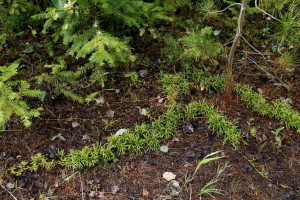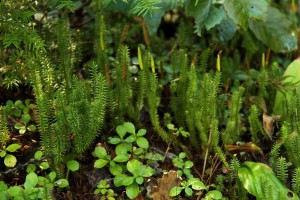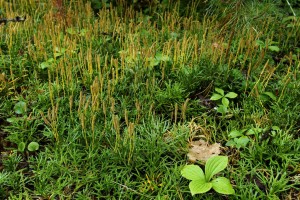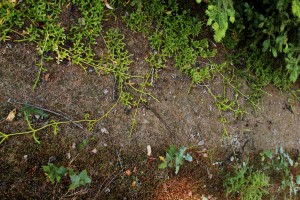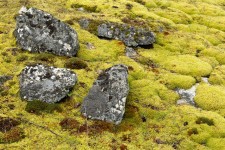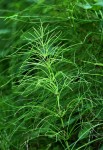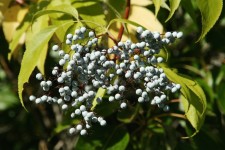Some plants catch your eye. During a walk on an overgrown road I was noticing the mosses and kinnikinnick along the road edges. Then I did a double-take when I saw a plant sprawled half-way across the road with fingers of the plant going every direction.
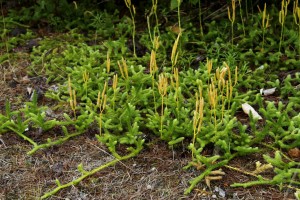
The strobilus is the spore-producing club often seen protruding above the leafy stems. Pictured is running clubmoss in the foreground and a few leaves of ground-cedar in the background. Regular moss is growing beneath the layer of dead needles.
The plant looked like a moss but was taller and had spore capsules larger than those of moss. Some of the plants looked like pine branches and others cedar branches.
After scouring my plant identification book, I realized these plants were clubmoss–neither a moss nor a pine. Botanists first thought they resembled moss which is why moss is in the name. The “club” part of the name comes from the club-like shape of the plant’s fertile stalk.
Clubmoss is categorized with ferns and horsetails because it is spore-producing and has a vascular system (a system to transport fluids and nutrients). While moss also reproduces by spores it doesn’t have a vascular system. Trees have a vascular system but reproduce by seeds.
Small, evergreen leaves characterize the low-growing clubmoss. On my walk I found three species of clubmoss: ground-cedar, running clubmoss and stiff clubmoss.
Ground-cedar is aptly named because it resembles western red cedar but grows horizontally instead of vertically. Each year’s growth is separated by a short portion of branchless stem which helps in identifying the age of the plant.
Running clubmoss is one of the world’s most widely distributed plants. The running clubmoss demonstrates how some clubmoss species spread by sending out rhizomes along the surface with growths of vertical stems at periodic intervals. The vertical stems of running clubmoss also create annual growth markers (like trees) because the stems produced earlier in the year are farther apart than those produced later in the year.
Many other clubmoss species resemble spruce and pine boughs leading to the nick-names of “ankle-high conifers”, princess pine or ground pine.
The main difference from conifers is that clubmoss reproduces via spores. Using the same life cycle as ferns, the clubmoss progresses through the gametophyte and sporophyte stages.
However, these stages are slow-going. A spore that germinates into a prothallus (gametophyte stage) can lie dormant for up to seven years. Once the prothallus begins to grow it can take up to 15 years to reach sexual maturity.
Only when water is available can the egg and sperm cells released make contact and grow into the visible sporophyte stage. Another five years may be needed for the sporophyte to produce the visible club-like fertile stalks called strobili that release the spores. Therefore, from spore to spore may take 20 years.
Once the plant is established, spores are plentiful and they have been sought after for hundreds of years. The spores have a unique combination of properties: uniform in size, high oil content and water-repellent.
Since the spores are uniform in size, scientists have used them as an aid in microscopic measurement.
With a high oil content, the spores are highly flammable. They were used in early flash photography, fireworks and theatrical displays.
Since spores are water-repellent, people have used spore powder (and still do) to stop nosebleeds, help diaper rash, as a drying agent for wounds, and as a body powder for bedridden patients. Spores have also been used to coat pills so they don’t stick together.
One of the most wide-spread uses of clubmoss goes unnoticed. Clubmoss has existed for millions of years. Prehistoric clubmoss has been buried, compressed and carbonized into the coal we mine today for electricity. That’s a lot of history for a plant sprawled across a road.

